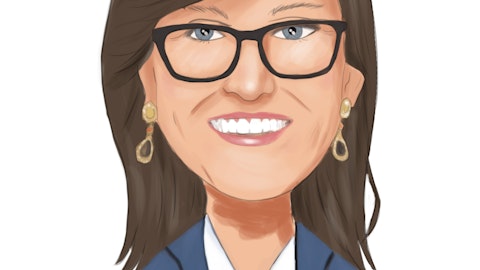Kenneth Worthington: Hi. Good evening. Thanks for taking the question. Alesia, you indicated a number of times that Coinbase increased spreads on retail trading this quarter. How are you determining the right spread for retail orders? What sort of capacity do you have to widen spread further over time? And then maybe for Paul, what ultimately gives Coinbase comfort that spread adjustments will be okayed by regulators over time.
Alesia Haas: Thanks for the question, Ken. So we’re frequently assessing pricing for different transaction types. So for example, spread applied to the fewer simple trading experience. It doesn’t imply to advance trading where customers are directly interacting with the order book and our customers have the choice of which products suits their experience best. So prices evolving. We don’t have a specific number that we’re targeting or a number of shares. We’re constantly assessing the right balance of meeting customer needs and driving our business and monitoring our pricing elasticity to see what resonates best with our user base.
Paul Grewal: Yeah. On the question of what gives us comfort that we’ll have the regulatory flexibility to continue with those practices, the simple answer is that it all comes down to our transparency about how we go about this and our commitment that we will honor whatever practices we disclosed as part of our terms of service and user agreements. We’re constantly evaluating these issues. And to the extent there are questions or concerns, of course, from any regulator, we will always respond to those promptly and appropriately.
Operator: Your next question comes from the line of Bo Pei with U.S. Tiger Securities.
Bo Pei: Hi, management. Thanks for taking my questions. So congrats on launching the Base Layer 2 tests now. I have two questions about Base. So first is well, if it’s still early, what is going to be the monetization model base? Do you plan to make money from Base or will be more like a public and you plan to fully decentralized network? And the second question is, well, it’s not common for crypto exchanges to launch their own block chains. The other exchanges are outside of the U.S., so they’re that’s regulated. However, Coinbase is a U.S. entity so faces a more challenging regulatory environment. How do you manage the risks of running a blockchain as a U.S. public company. For example, if some apps on base offer non-compliance services to U.S. resident, how do you make sure Coinbase will not become the target of U.S. regulators? Thanks.
Brian Armstrong: Yes. Thanks, Bo, for the question. I’ll start off and then Paul, if others want to add anything, feel free. So the first part of your question was on monetization. And it’s too early to say on how Base could be monetized. Again, we’re still in testnet. We haven’t even launched mainnet. We’re just trying to build out the ecosystem at this point. We definitely made a conscious decision not to have a token associated with the blockchain, which touches on the second part of your question. Because we are a U.S. entity and this blockchain is something that we’re helping initiate, we wanted to make sure there was no token associated with it because we didn’t believe that there was a way to do that. There wasn’t a way to basically register a token to do that in the U.S. at the moment.
But our goal is for this also to be decentralized over time, and that’s another big piece of the puzzle. Base is going to be a decentralized chain. And so it’s something we may contribute to — as one of many parties that contributes to it, but it’s not going to be something that’s run solely by Coinbase. Paul, anything you want to add?
Paul Grewal: I think, Brian, you said it well. This is not something that over time will be run by Coinbase. Our goal is decentralization. We consciously chose not to include a token as part of the offering. And we think that in combination and with increasing adoption over time as we move out of testnet, hopefully, sooner rather than later, but that remains to be seen. We’re going to see a very positive response not only from the public, but also from regulators as well.
Operator: Your next question comes from the line of Devin Ryan with JMP Securities.
Devin Ryan: Thanks very much. Just a question on the international derivatives exchange. Just great to hear how quickly you guys think you can scale it to become a material contributor if you can quantify the addressable revenue market for Coinbase? And then on the expense side, will there be incremental expenses needed to get to where you want to go versus how much kind of existing infrastructure of the firm can you leverage just as you scale that? Thanks.
Alesia Haas: Great. Well, we’re not preventing in a revenue outlook at this time. But as you know, the derivative markets are multiples of the spot market in crypto generally, and that’s true inside by as well. So this is large volume opportunities. This is our initial launch. We have two order books. We are just beginning to onboard market makers. So this is early days, and we’ll give you more updates as this product matures. All of the expenses needed to operate this platform are included in our current expense base and in our Q2 outlook for expenses.
Operator: And your final question comes from the line of Joseph Vafi with Canaccord Genuity.
Joseph Vafi: Hey, guys. Good afternoon. Just I thought maybe we’d circle back, Brian, to your original comments here on financial enablement. And perhaps you could give us a view on some of the things you’re working on that front? And then just on just kind of interested also in your Layer 2 rollout and what you’re thinking there and the strategy? Thanks.





